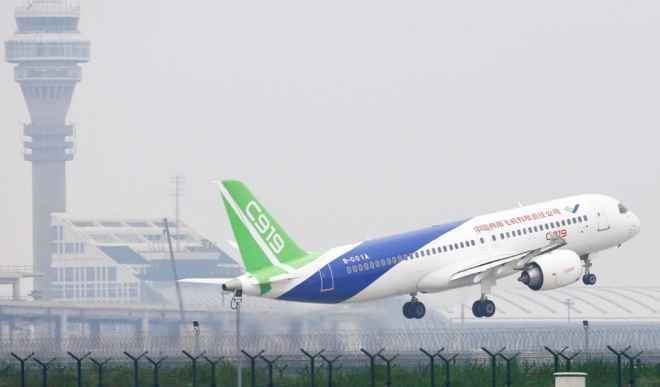Test flight of China’s first homegrown passenger jet
Aviation superiority is a prerequisite for a country to lead in technology. China, which is perhaps the world’s most strategic country today, knows this fact very well. The country has focus and seems to be looking 1,000 years into the future. Thanks to the able leadership, patriotic fervor, and the humongous ambition to dominate the […]


Aviation superiority is a prerequisite for a country to lead in technology. China, which is perhaps the world’s most strategic country today, knows this fact very well. The country has focus and seems to be looking 1,000 years into the future. Thanks to the able leadership, patriotic fervor, and the humongous ambition to dominate the world, not just in population and potential market size – which it has already achieved by default of creation and national stability – but in virtually everything good. The embarrassment of its essentially zero portfolio in aviation technology had long hit home in China, and as far back as the early 1970s, China has set out to change the status quo. So, it asked its scientists and engineers to go to work and deliver top-notch aerospace technology – apparently by any means possible.
Buoyed by superior political leadership, patriotism, and a definite aim, everyone in China went to work. Now the fruits are coming out. One of the harvests was displayed on 5 May 2017 when the first large China-made passenger jetliner, C919, completed its maiden test flight. This event is obviously a milestone in the country’s long-term goal to break into the US and Europe-dominated aircraft market.
Thus, while the previous leaders of fellow developing countries like Nigeria – which has so many natural resources compared to China – were engulfed in corruption, embezzling government money, and essentially bankrupting the country, China was developing its world leadership portfolio. Now, Nigerians line up by the hundreds outside the Chinese embassies to apply for Chinese visas! And if you think it was easy for China to achieve this feat, please think again. Many developing countries just don’t have the discipline!
The Chinese government-owned aviation company, COMAC (the Chinese-government-owned Commercial Aircraft Corporation of China Limited), was charged with the building of C919, the 168-passenger jetliner that would compete with Boeing 737 (U.S.) and Airbus A320 (Europe). The C919 was originally scheduled to enter into service in 2018, after several delays. With the look of things, that date has been moved backwards, so that C919 may not start operating until 2019 or even later. At any rate, the one-hour long C919 test flight, with take-off and landing at Shanghai Pudong International Airport, was a spectacular success.
The First in Flight in America was over 100 years ago, while American commercial aviation is almost 70 years old. So, evidently, China is coming quite late into the game. However, it has not been for lack of trying on the part of China. In fact, building a commercial airliner has been a priority of the Chinese government for over 40 years. Unfortunately, when it comes to aerospace technology, China has no friends! That is, no company or country wants to help China develop its aerospace technology – not even Russia. With China’s huge population – over 1.3 billion people – and the flourishing middle class, with the money to fly – no country or aerospace company can afford to willingly cede that humongous business opportunity in China to China.
As pointed out in a previous article in this column, “aerospace projects – be it civilian or military, tend to be highly protected by the inventors, and the very strict export control laws that are in force in developed countries, limit accessibility of others to the technologies. There are obviously political, military, as well as economic reasons for wanting to be tight-fisted with aerospace technology.” You can now understand why countries like the U.S. have deployed commercial jets as far back as more than 60 years ago, whereas China is still trying to build its first in 2017, with projected deployment in 2019.
The C919, which is “single-aisled” and “twin-engined,” will, as pointed out above, take on the famous Boeing 737 and Airbus 320 jetliners. Incidentally, the specs for C919 versus Boeing 737 are strikingly similar: Wingspan – or the length of the wing (35.4 meters, 35.8 meters), cruise speed (903 km per hour, 879 km per hour), maximum altitude (12.1 km, 12.5 km), number of passengers (168, 210). These similarities have raised some eyebrows in the aviation industry!
Building C919 is one thing; having airlines that would adoption it is a completely different story. Reports have it that more than 570 orders have already been placed for C919 by 23 airline companies worldwide. However, most of these orders have come from Chinese airlines, which are mostly government-owned and are probably mandated by the government to switch to C919 and do away with Boeing 737 and Airbus A320 in the long run. For airline companies from other countries, the game will probably be that of watchful-waiting; to see how C919 performs safety-wise in relations to the competing, more established alternatives. Some estimates put the watchful-waiting period to almost 10 years.
Another potential show-stopper for C919 is foreign government certification, which, for example, has prevented an earlier Chinese small plane deployment to operate in the US.
